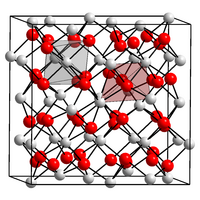Holmium (III) oxide
| Crystal structure | ||||||||||||||||
|---|---|---|---|---|---|---|---|---|---|---|---|---|---|---|---|---|

|
||||||||||||||||
| __ Ho 3+ __ O 2− | ||||||||||||||||
| General | ||||||||||||||||
| Surname | Holmium (III) oxide | |||||||||||||||
| other names |
Holmium oxide |
|||||||||||||||
| Ratio formula | Ho 2 O 3 | |||||||||||||||
| Brief description |
yellowish solid |
|||||||||||||||
| External identifiers / databases | ||||||||||||||||
|
||||||||||||||||
| properties | ||||||||||||||||
| Molar mass | 377.86 g mol −1 | |||||||||||||||
| Physical state |
firmly |
|||||||||||||||
| density |
8.4 g cm −3 |
|||||||||||||||
| Melting point |
2330 ° C |
|||||||||||||||
| boiling point |
3900 ° C |
|||||||||||||||
| solubility |
almost insoluble in water |
|||||||||||||||
| safety instructions | ||||||||||||||||
|
||||||||||||||||
| As far as possible and customary, SI units are used. Unless otherwise noted, the data given apply to standard conditions . | ||||||||||||||||
Holmium (III) oxide is a chemical compound from the group of oxides .
history
In 1878 the Swiss chemists Marc Delafontaine and Jacques-Louis Soret discovered the element holmium spectroscopically through its deviating absorption lines. In 1879 the Swedish chemist Per Teodor Cleve discovered the new element independently of the two Swiss people and isolated it as a yellow oxide from impure erbium oxide . Cleve used a method developed by Carl Gustav Mosander ; it first separated off any known impurities before attempting to separate the rest. He received a brown residue, which he named Holmia , and a green residue, which was named Thulia .
It was not until 1911 that the Swedish chemist Holmberg succeeded in obtaining pure holmium oxide.
Occurrence
Holmium (III) oxide occurs naturally in traces in the minerals gadolinite , monazite and other rare earth minerals .
Extraction and presentation
Holmium (III) oxide is formed during the oxidation of holmium :
It can also be obtained by thermal decomposition of holmium salts such as holmium nitrate or holmium oxalate.
properties

Holmium (III) oxide is a yellowish solid that is insoluble in water. It reacts with acids to form cations, which in turn react weakly acidic in water.
use
Holmium (III) oxide is used as an additive in glasses for optical filters, since it shows strong absorption in narrow frequency ranges in visible and UV light. It is also used in the manufacture of metal halide lamps.
literature
- DW Allen: Holmium oxide glass wavelength standards . In: Journal of Research of the National Institute of Standards and Technology . tape 112 , no. 6 , 2007, p. 303–306 ( abstract ; full text ; PDF ).
Individual evidence
- ↑ a b c d e f g h data sheet Holmium (III) oxide, powder, 99.999% trace metals basis from Sigma-Aldrich , accessed on March 4, 2012 ( PDF ).
- ↑ Gerd Meyer, Lester R. Morss: Synthesis of lanthanide and actinide compounds . Springer Netherlands, 1990, ISBN 978-0-7923-1018-1 , pp. 195 ( limited preview in Google Book search).
- ^ Periodic table online: Holmium
- ↑ Hellma-analytics: Holmium oxide glass filter
- ↑ Reade: Holmium Oxide Powder (Ho 2 O 3 ) ( Memento of the original from January 9, 2012 in the Internet Archive ) Info: The archive link was inserted automatically and has not yet been checked. Please check the original and archive link according to the instructions and then remove this notice.

